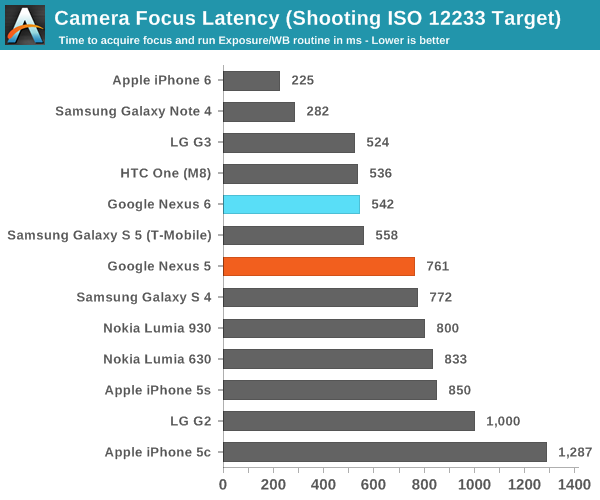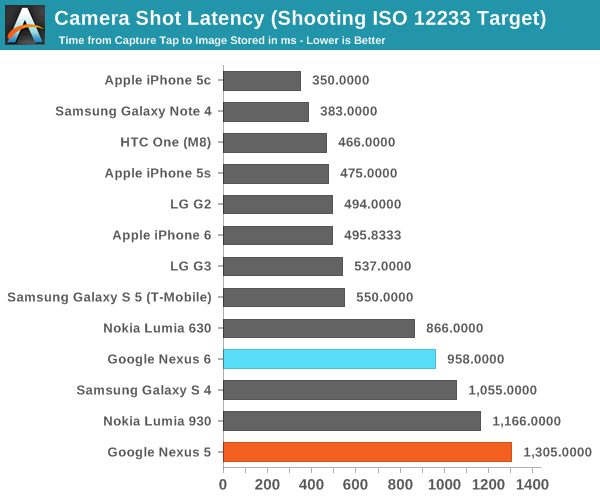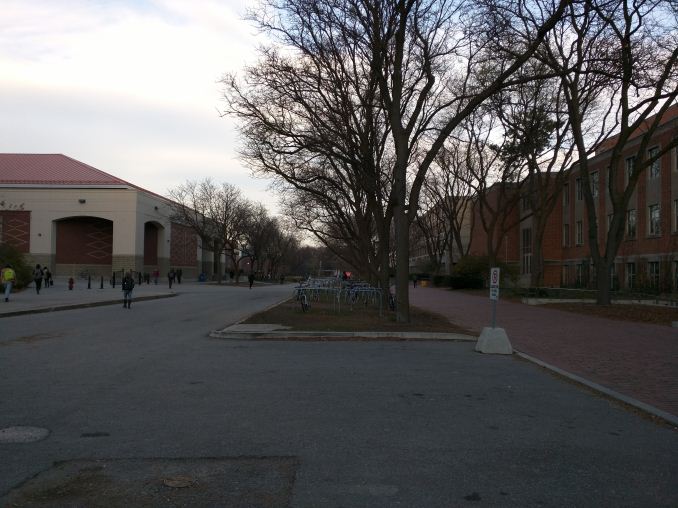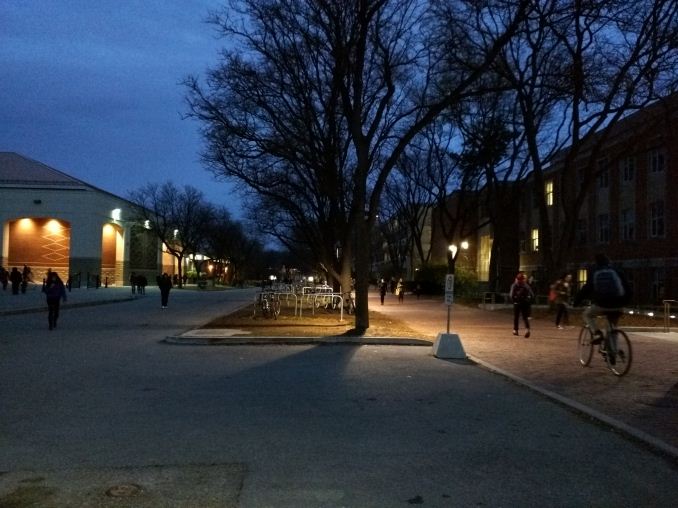The Nexus 6 Review
by Brandon Chester on November 12, 2014 1:00 PM ESTCamera
The camera has always been something of a pain point for Nexus devices. Since the Galaxy Nexus launched we've seen camera sensors that always seemed to be one step behind the competition. The price point that Google had aimed for with their Nexus phones certainly contributed to this, and software issues like upscaled, stretched, or cropped previews did not help the situation either. With the Nexus 6 being priced as a premium device, one would hope that it sports an equally premium camera, and indeed it does. The Nexus 6 uses Sony's IMX214 with an F/2.0 aperture and OIS for the rear camera, a sensor we've seen in HTC's Butterfly 2, and the OnePlus One just to name a couple of examples. I'm happy with Google's decision to continue using 4:3 camera sensors which tend to make framing scenes easier than 16:9 sensors in my experience.
Before looking at photos taken with the Nexus 6, it's important to look at how fast it is able to focus and capture photos. After all, if your phone takes too long to focus, the moment you wanted to photograph may already be over by the time you can take the shot.


The Nexus 6 has a focus latency which is competitive with some of the flagship devices released this year like the LG G3 and HTC One (M8), but it's not in the same class as the recently released iPhone 6 and Galaxy Note 4. The shot latency is also surprisingly long, and I repeated the test multiple times to confirm. The Nexus 5 also had a long capture time, and so it may be that this is a result of issues in Google's Camera application rather than anything relating to the device's camera itself.
The Nexus 6 seems to vary its ISO between 40 and 1200, while the Nexus 5 typically varied between 100 and 1600 with some extremely high values as high as 3000 in certain circumstances. I was only able to get exposure time up to 1/12th of a second which is somewhat fast for a device with OIS. The Nexus 5 wasn't shy about going up to 1/6th of a second if it needed to.
The camera software is also an important aspect of mobile photography. Google's Camera application is actually quite good for a relatively automatic photo experience. I do think that Google could expose more of the controls like switching between camera modes and toggling the flash as constantly visible controls without reducing the amount of space for the preview significantly. Something I noticed while using the Nexus 6 is that the colors of the preview in the viewfinder were quite saturated. This is, of course, due to the display calibration, which unfortunately means that the viewfinder is not very helpful in determining how the photo is actually going to look. The preview framerate also tends to run below 30fps which has been the case for a long time now, but I hope that pointing it out will eventually get it improved.
Still Image Performance
These next tests use photographs of an outdoor area at various times to guage the performance of a smartphone's camera relative to other smartphones, as well as a controlled test scene inside a well lit area. I am unfortunately limited by the number of devices I have on hand, which at the moment includes the Nexus 6, iPhone 6, Nexus 5, and HTC One (M7).
Before getting into the actual tests I wanted to mention something about smartphone camera white balance that won't be apparent based on the images alone. Based on how I actually saw the scene as I was taking the photos, I can confidently say that the Nexus 6 consistently had a far more accurate white balance than any of the other devices I tested. This can actually have a huge impact on the overall appearance of the image, and it can be easy to overlook when doing these sorts of comparisons. For example, the iPhone 6 photo in the evening test has a shift toward blue that makes it appear to be much darker out than it actually was, while the Nexus 6 more accurately reflects how the scene looked at the time. With that out of the way, lets begin with the daytime test.
In this first test the Nexus 6 performs very well. I would say it produced the best overall image of the four devices I tested. The higher resolution sensor allows for greater sharpness and detail in areas like the branches of the trees, and the bars of the black metal gate on the left side are only captured with sufficient detail by the Nexus 6. However, I did notice an issue with the output from the Nexus 6, which is a concerning amount of blur in the section of branches that is to the right of the centre of the image, but not at the very right edge of the frame. I took several photos and even repeated the test on a different day, but the issue persisted.
In this next test we have the same scene at a later time of day with less natural lighting. The performance of the iPhone 6 approaches the Nexus 6 due to its larger sensor pixels giving it an edge in low light circumstances, but the Nexus 6 still maintains an overall higher level of detail and sharpness, particularly on the trees.
With the outdoor scene in low light we can see that all of our devices start to struggle. The Nexus 6 ends up sharper and less noisy than the Nexus 5 by driving a much lower ISO of 1200 instead of 2500. However, the brick building on the right shows that although the OIS on the Nexus 6 allows for a longer shutter time, Apple's iPhone 6 is able use a lower ISO and better preserves detail with finer grained noise throughout the image in general.
The last test we perform is a highly controlled test scene with generous lighting and different textures to see how well the Nexus 6 is able to capture detail in something of a best case scenario. In this case the Nexus 6 once again provided the best sharpness and detail preservation of all the devices I tested. The white balance is shifted toward pink which is an odd exception from the performance in the other tests.
I'm very happy with the improvements Google has made to their camera on the Nexus 6. I no longer feel like Nexus devices will always be a generation behind the competition when it comes to camera quality. Google and Motorola should also congratulate themselves on their white balance algorithm which helped the Nexus 6 to take photos that better reflected how the scenes actually looked in real life. I hope Google will continue to improve their camera software to make the user interface less menu driven, and to improve capture times for photos which is the one area that the Nexus 6 really falls behind its competition.






























136 Comments
View All Comments
Brett Howse - Friday, November 14, 2014 - link
It's removed and I was "that reviewer".Apparently wifi scores are the single most critical piece of any smartphone review so this won't happen again.
jaysns - Thursday, November 13, 2014 - link
If you do the storage performance tests with the encryption enabled and disabled on the Nexus 5 you see a huge difference. As the 6 comes with this on by default and does not have a way to manually disable this (as far as I know) I'd love to see a follow up article by Anandtech on this issue and see if they can reproduce this and possibly find a way to disable it on the Nexus 6 and compare results. Based on what I've seen, if I can't disable it, or their storage is really just that slow, it would make a difference on my purchasing decision and possibly help other in the same boat. So please do a follow if you can :)Vizsla1986 - Thursday, November 13, 2014 - link
This particular review is an outlier against all the others, which are basically raves. Some of that is explicable - a lot of sites do pro forma reviews colored by a priori bias - but not all.Since I'm someone who purchased the original Moto X (loved it), upgraded to the Droid Turbo a couple of weeks ago (hated it. Returned it immediately) and then bought a 2nd Gen Moto X, a couple of comments based on actual experience.
1) Everyone needs to look at specs with a jaundiced eye. Sometimes they matter (storage) and sometimes it's contextual (RAM, for example. Depends on how system is used) but most of the time it's about throughput.
2) The Moto X was at least as fast, if not faster on throughput then every phone I compared it to, despite worse specs. A lot of that was display. 720 p is a lot easier on a system than 1080, but also not nearly as good. The 2nd gen. Moto X is *faster* in everyway, IMHO, than the Droid Turbo. I'd say that's also display-related, but the difference here is that the Turbo's screen (same as the Nexus 6) wasn't any better to my eyes than the Moto X 1080. YMMV, but one should carefully check this out. If you can't tell the difference (or much of one) consider the system impact.
2) The Moto X is clearly as fast (actually seems faster) as the Turbo despite an 801 chip compatred to the 805, and different clock speeds. Since I haven't had a chance to handle the Nexus 6, I can't compare, but I would urge anyone considering to pick the the two phones and compare throughput.
3) Clearly the Phablet Nexus 6 is a different experience than a smaller phone. I'm struck, though, that every single review I've read (maybe 6 of them now) has screamed themselves hoarse about how good the Nexus screen is. It's ok to be different, but *that* different? I'd recheck my report if I were the only person criticizing what everyone else thought the best thing about the phone. That's not different. That's idiosyncratic. On a phone this big, display quality is a simple thing to judge. There may be subtleties presenting on measurement, but one should be able at a glance to judge good or bad. I find this review suspect on that ground, never mind the measurements. FWIW, the DROID TURBO was bright enough. So is the Moto X. Why should the Nexus 6 be so different?
4) The price seems eminently reasonable, considering dimensions and specs. I understand why people want to see a cheaper Nexus alternative, but pricing needs to compared against delivered value, not just what one wished for.
5) Battery life. FWIW, I have never, ever, ever never needed to recharge any of the three Motorola phones I've had recently (Moto X Nos. 1 & 2 and the Droid Turbo)before going to bed. Once in a while I've drained to to a 10% remaining, but that would be it. The Turbo had an immense batterry (3900), so that's one explnation, but the 2nd Gen Motox X has only 2400 (from memory. Might be 2200). No problem. Motorola engineers are good at designing systems that get through the day on a charge. The Nexus has what? 3200? That ought to be good enough.
To be fair, everything depends on usage, and I'm not the hardest guy on batteries out there. I watch very little media (so no display drain), mostly calls, text and browsing. Someone else might have a much worse time of it. All I can attest to is my Moto phones have been spectacularly good (for me, anyway).
When I make a major purchase, I always check various vendors and compare thoroughly. If this review were in a purchase matrix I was running, I'd throw it out. It's always been a good policy for me to disregard the high and low bidders (or reviews) unless there was an exceptional circumstance. I don't see one here. I don't trust this review. I can't remember ever saying that about any other AnandTech report.
Graag - Sunday, November 16, 2014 - link
>This particular review is an outlier against all the others, which are basically raves. Some of that is explicable - a lot of sites do pro forma reviews colored by a priori bias - but not all.This is not true at all. Both the arstechnica and Verge reviews also found the Nexus 6 to be "meh".
randomlinh - Friday, November 28, 2014 - link
I dunno, most of the reviews seemed like a mixed bag to me, though leaning positive. But on the screen... AT is one of the only site to give tested numbers. Everyone has been a subjective "it looks great, just a little dim, but probably bright enough". That's not entirely helpful.The Note 4 gets a huge nod from displaymate which seems to mirror the results here: http://www.displaymate.com/Color_Accuracy_ShootOut...
gg555 - Thursday, November 13, 2014 - link
Sigh. No review of the noise cancellation. No mention of whether or not it has the four microphone noise cancellation found in the Moto X. No mention of whether it uses Motorola's CrystalTalk, Qualcomm's Fluence, Audience, or some other noise cancellation.My favorite part of the AnandTech cell phone reviews has totally died. And they were the only one doing it. What a shame.
davidc1 - Saturday, November 15, 2014 - link
Yes, yes, yes! Why no mention of audio quality, call quality, noise cancellation, etc, etc. Very disappointed.lanwellon - Thursday, November 13, 2014 - link
Hi, Brandon, I think you should point out that the reason why the Nexus 6 use the battery so quick is not all because of the bigger screen and more powerful CPU, please be noticed that in all the mobile phones you tested in this table, Nexus 6 is the only one running Android L, and Google enabled FDE (Full-Disk Encryption) function by default from Android 5.0. From my experience using Android 4.0 (Ice Cream Sandwich) FDE function, this can be a reason that cause the battery running down very fast. iPhone also enable FDE function by default, but it seems that Apple optimized it pretty well, so the impact to the battery usage is not that big.ol1bit - Friday, November 14, 2014 - link
There is always a segment of the population that buys Nexus devices because they are factory boxes. This is too make sure people who want a Samsung, HTC, etc. phone are not swayed by the low price to a Nexus device. Goggle doesn't want manufactures to die off, the price of a phone is not how they make their money.murphsp1 - Friday, November 14, 2014 - link
I have owned several Nexus devices and must say that the battery life numbers on this one look terribly disappointing ... and will only get worse over time. I just hope that more manufacturers start to understand that many would happily trade off an extra mm or two in thickness for an extra day of battery life. Now, fingers crossed that the Google Play edition of the Droid Turbo is coming ...